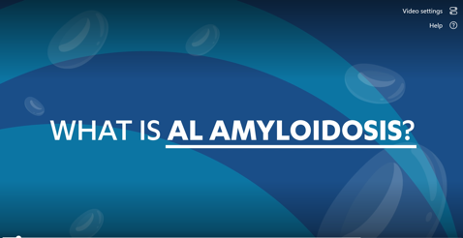AL Amyloidosis
About AL amyloidosis
AL amyloidosis is one of the most common types of amyloidosis – a rare type of blood disorder. It occurs when abnormal white plasma cells in your bone marrow produce too many misfolded proteins (light chains) that form deposits (amyloid deposits). These deposits cause a build-up of fibrils which create blockages that keep essential organs – such as the heart, kidneys, liver, spleen, nerves or parts of the digestive system – from working properly. The condition can seriously impact quality of life and may at times lead to organ failure.

It is estimated that around 5000 people are newly diagnosed with AL amyloidosis each year in the European Union. Still, diagnosis is often delayed since the symptoms may be non-specific, often mimicking other conditions, and also because it is a relatively rare condition.
A late diagnosis is concerning given the severity of the disease, which can be life-threatening if the symptoms and causes are not appropriately managed.
Although AL amyloidosis is not cancerous, the condition may occasionally be associated with a rare type of blood cancer that also starts in plasma cells called multiple myeloma. While treatment approaches may be similar, there is a key distinction between the two diseases. In multiple myeloma there is an abnormal growth of cells in the bone marrow, while in AL amyloidosis the problem stems from a build-up of proteins (light chains) produced by abnormal cells.
Types of amyloidosis
Though AL amyloidosis is the most common form of amyloidosis, there are several types of the condition. Most patients only suffer from one type, but on rare occasions two types have been found in one patient. The nature and source of the protein determines the kind of therapy needed: 91011
Amyloid A (AA) amyloidosis
This type affects the liver (in 80% of cases) or kidneys when someone has a chronic infection or inflammatory disease, such as diabetes, Crohn’s disease, or tuberculosis.
Hereditary amyloidosis
This is caused by a specific gene variant which results in the body producing amyloid proteins that form into an abnormal shape.9 If you have this type, you carry the gene variant from birth, and you may not experience any symptoms until adulthood, or even at all. However, you can pass it on to your children whether you have symptoms or not. This type affects a wide range of organs, but is common in the kidneys, liver and spleen, as well as the heart and nerves.
Wild-type amyloidosis
This type is unusual because there is no genetic or underlying health reason for it.10 Despite the body creating seemingly normal cells, build-up still occurs. This type is found primarily in men in their 70s, and most commonly affects the heart; medical experts associate this type with old age.11
Causes
AL amyloidosis is caused by an overproduction of light chain proteins which misfold and bind together to form amyloid fibrils that are then deposited into organs. However, scientists do not yet fully understand why someone produces too many light chain proteins. It is likely to stem from a combination of both genetic and environmental factors.12
That said, certain risk factors may increase the likelihood of someone developing AL amyloidosis:
- Age: the median age at diagnosis is 63 years old 13
Being male: approximately 55% of people living with AL amyloidosis are male 13
Individuals with monoclonal gammopathy of undetermined significance (MGUS), a condition where low levels of white plasma cells produce the light chain proteins that may form amyloid, are nine times more likely to develop AL amyloidosis: 13
Having multiple myeloma—people with multiple myeloma may develop AL amyloidosis 14
